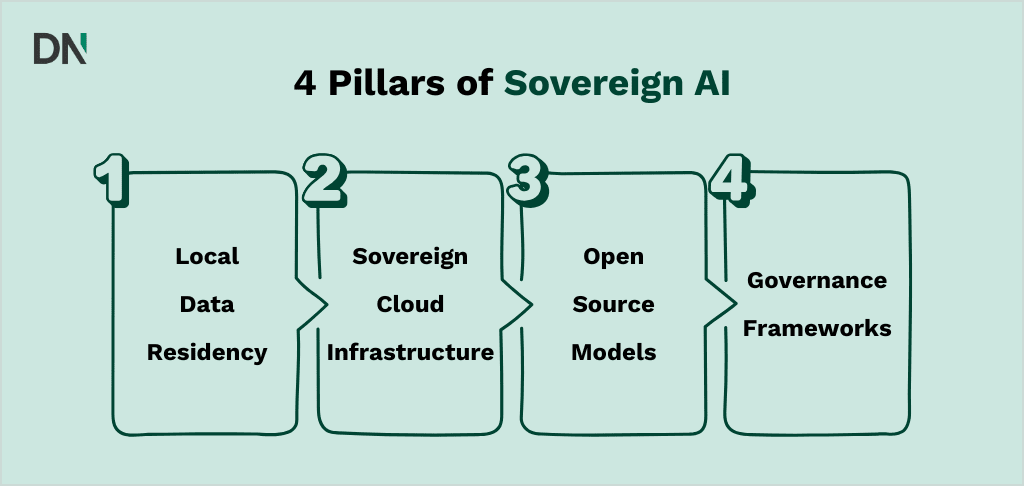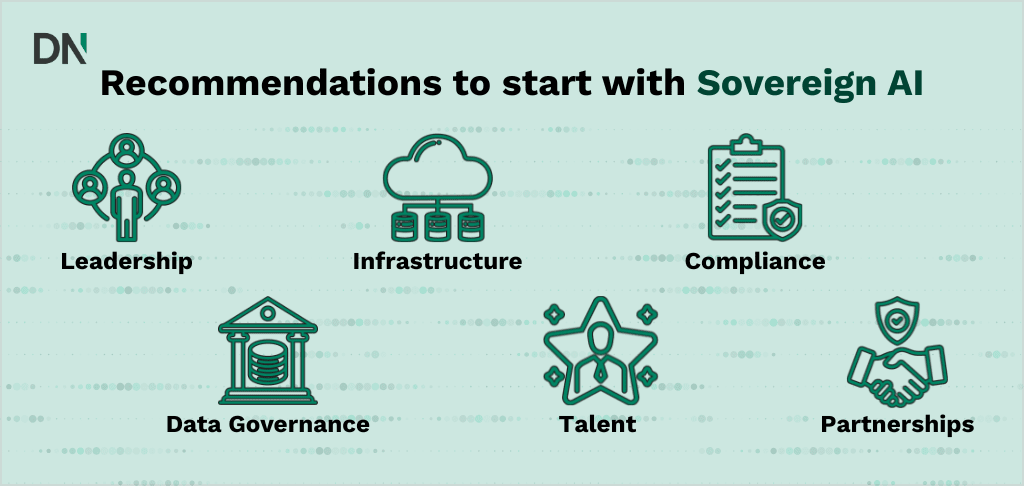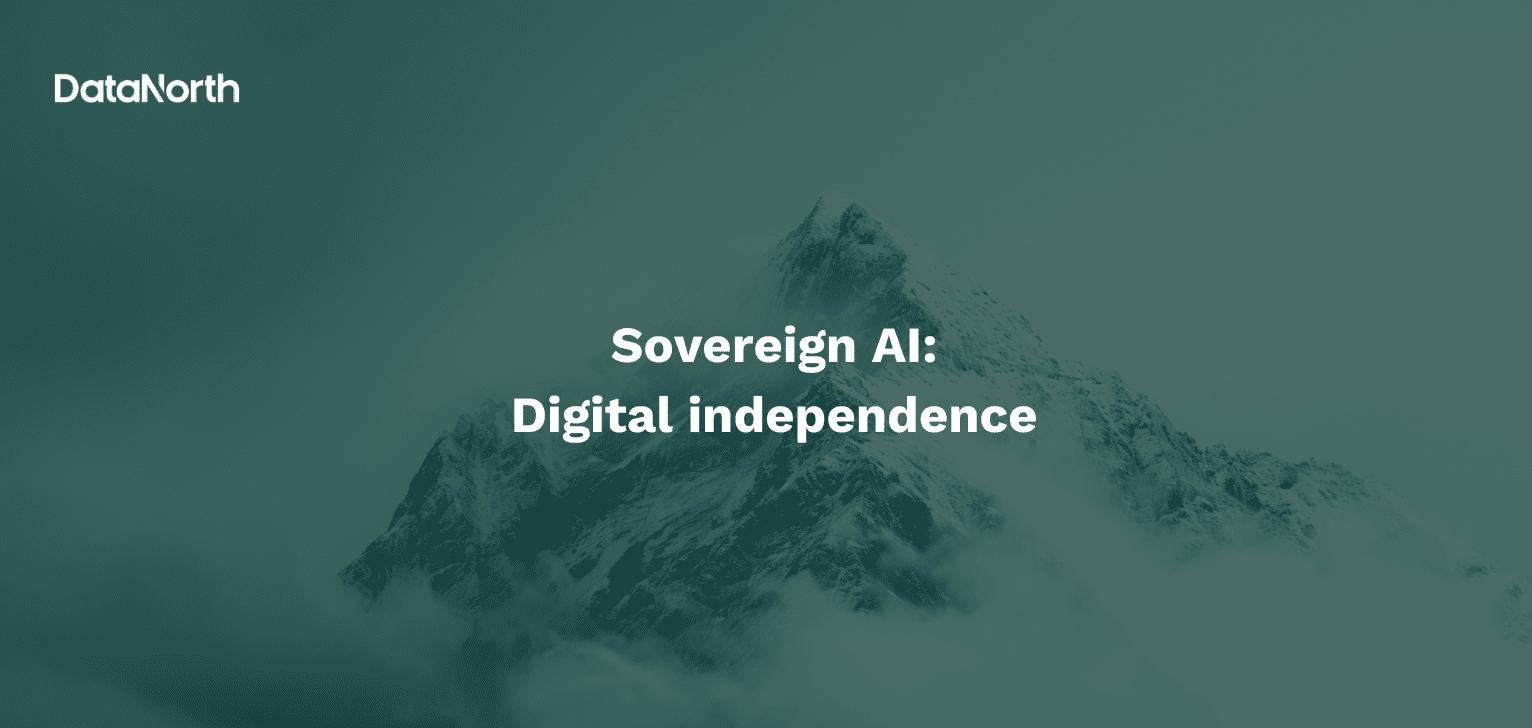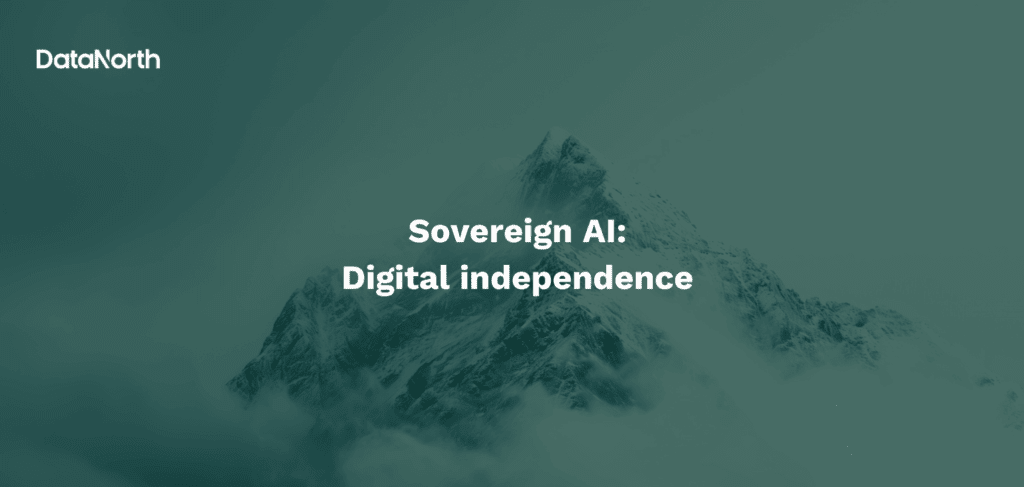Sovereign AI is becoming a critical priority for nations and enterprises worldwide. Defined as the ability to independently develop, maintain, and deploy AI systems using local infrastructure, data, workforce, and business networks, sovereign AI represents both a defensive necessity and strategic opportunity in an increasingly fragmented geopolitical landscape.
Why sovereign AI matters now
The strategic importance of sovereign AI rests on three pillars:
- Technological sovereignty (control over infrastructure, models, and hardware),
- Operational sovereignty (local management by trusted personnel),
- Data sovereignty (data collected, stored, and processed within national borders under national governance).
Driving this urgency are four converging factors.
- First, Accenture’s 2025 research reveals 62% of European organizations are seeking sovereign solutions in response to geopolitical uncertainty, with particular concern among Danish (80%), Irish (72%), and German (72%) organizations.
- Second, regulatory requirements have become mandatory: the EU AI Act establishes strict frameworks for high-risk systems, particularly in banking (76% adoption), public services (69%), and utilities (70%).
- Third, economic competitiveness demands control over AI capabilities: investing in sovereign AI could boost GDP by up to 15% by 2030, with the European Union mobilizing €200 billion through its InvestAI initiative.
- Finally, compliance with GDPR and sector-specific regulations requires data residency and governance that only sovereign approaches can fully guarantee.
Technical foundations
Sovereign AI rests on four interconnected pillars:

- Local data residency ensures data storage and processing occur within designated jurisdictions, complying with GDPR requirements for cross-border data transfers. Banks implement this through hybrid cloud models combining local storage with compliant services or on-premises data centers for sensitive applications.
- Sovereign cloud infrastructure provides dedicated computing environments for single organizations. European providers like Nebius, Nscale, CoreWeave, and Lambda offer modern architectures with European data residency, enabling enterprises to scale AI securely without foreign jurisdictional exposure.
- Open source models and tools enable technological autonomy without isolation. Access to open-weight models such as LLaMA, Falcon, Qwen, Mistral, and BLOOM allows organizations to adapt systems to specific needs while maintaining transparency. This approach demonstrates that sovereignty and global collaboration are compatible through open source methodologies.
- Governance frameworks aligned with the EU AI Act ensure responsible deployment. The Act categorizes AI systems into four risk levels, with high-risk systems in banking, healthcare, and public services requiring rigorous risk management, technical documentation, human oversight, and accuracy standards. Key compliance milestones include February 2, 2025 (prohibited practices), August 2, 2025 (general-purpose AI rules), and August 2, 2027 (high-risk system requirements).
Implementation across sectors
Banking leads adoption at 76%, implementing sovereign AI for fraud detection and risk assessment while maintaining data protection. The EU AI Act automatically classifies creditworthiness and credit scoring systems as high-risk, necessitating comprehensive compliance frameworks that align with existing BCBS 239 principles and Basel model validation requirements.
Public services demonstrate 69% adoption, using platforms like Hopsworks for air-gapped environments and on-premises deployment. Sweden’s Arbetsförmedlingen exemplifies success, using sovereign solutions for job recommendations and NLP applications while maintaining strict data sovereignty.
The Netherlands exemplifies European leadership through multiple initiatives. GPT-NL, will become the country’s first Dutch-English language model funded with €13.5 million. It addresses concerns about foreign models lacking transparency and adequate Dutch-language training data. The Groningen AI Factory, operational by January 2027, will combine supercomputing infrastructure, expertise centers, and collaborative spaces specifically designed to make AI development accessible to SMEs and organizations lacking such resources. TNO contributes AI expertise from developing GPT-NL, while SURF handles hardware management.
European coordination and infrastructure
Gaia-X represents Europe’s most ambitious initiative for sovereign, interoperable data infrastructure. Launched in 2020 by German and French leadership, the initiative creates interconnected nodes based on open standards, enabling secure information exchange across sectors including healthcare, automotive, energy, and mobility. More than 180 data spaces operate in implementation phase, with frameworks like Catena-X in automotive demonstrating practical sectoral coordination.
Federated learning enables collaborative model training while maintaining data sovereignty. This approach keeps data where it originated (hospitals, financial institutions, cloud regions) while still contributing to shared models, ensuring compliance with data localization mandates and enabling organizations to collaborate on shared AI systems without centralizing sensitive information.
Dutch participation includes technical integration through TNO, with test environments linked to Italy and Spain for cross-border cloud federation, bringing European standardization into operational practice.
Challenges and realistic pathways
Significant hurdles remain. Skills gaps threaten European ambitions as more AI engineers choose to work in the US opposed to the EU. Besides that Europe must triple data center capacity within five to seven years, requiring €400 billion investment to unlock AI’s potential €1.2 trillion GDP contribution.
However, complete AI independence proves neither necessary nor desirable. Successful strategies recognize that 36% of AI initiatives in European organizations require sovereign approaches, with capital markets and public services needing higher sovereignty shares. Hybrid models combining national control with international collaboration, shared compute infrastructure, federated governance, and pre-trained models demonstrate that partial sovereignty achieves objectives without prohibitive costs.
European organizations increasingly adopt hybrid approaches: 57% consider using sovereign solutions from both European and non-European providers, acknowledging that remaining competitive requires access to global innovation while protecting critical data and strategic capabilities.
Investment and market dynamics
Europe’s commitment is substantial. The EU’s InvestAI initiative mobilizes €200 billion for AI research and infrastructure, including €20 billion for up to five AI gigafactories. Europe’s AI market, valued at €66 billion in 2024, is projected to reach €370 billion by 2030 (approximately 32.5% CAGR). IT spending surges 11% in 2025 to €1.3 trillion, with GenAI investments growing 78% as organizations increase spending on AI, cloud, and cybersecurity.
A Gartner survey reveals 61% of Western European CIOs want to increase local cloud provider usage, with 53% stating geopolitics will restrict future global provider use. Interest in sovereign cloud infrastructure, powered by geopolitical uncertainty and regulatory mandates, is driving investment in European providers offering data residency and regulatory compliance.
Actionable recommendations

For leadership: Make sovereign AI a CEO-led priority aligning with enterprise risk, growth, and geopolitical realities. Classify AI systems by sovereignty requirements, targeting investment where genuine compliance or data sensitivity demands local control rather than applying uniform approaches.
For data governance: Implement comprehensive classification and access controls, tagging data by sensitivity and enforcing role-based restrictions. Deploy locally hosted solutions for sensitive data using on-premises or sovereign cloud infrastructure. Use policy-as-code for automated compliance monitoring ensuring data remains in approved jurisdictions.
For infrastructure: Large enterprises should evaluate sovereign cloud providers offering European data residency and EU regulatory compliance. SMEs should access shared facilities like the Groningen AI Factory, which provides affordable pathways to AI development technology without building complete infrastructure independently.
For talent: Invest in comprehensive AI literacy programs addressing EU AI Act requirements. Develop specialized capabilities in AI engineering, MLOps, data science, and compliance. Leverage EU AI Skills Academy initiatives while building internal training programs.
For compliance: Conduct AI risk assessments mapping systems to EU AI Act categories. Implement governance policies with clear responsibilities and human oversight mechanisms. For financial institutions, extend existing regulatory frameworks (BCBS 239, Basel requirements, GDPR) to address AI-specific risks.
For partnerships: Build hybrid ecosystems combining local trust with global innovation. Participate in federated learning initiatives, engage with Gaia-X data spaces, and establish partnerships preserving control over critical data and models.
Conclusion
Sovereign AI has transitioned from theoretical concept to strategic imperative. The EU AI Act, combined with €200 billion InvestAI commitments, geopolitical fragmentation, and data privacy requirements, has elevated AI sovereignty to critical infrastructure status comparable to energy grids and transportation networks.
The Netherlands exemplifies European leadership through GPT-NL language model development, the Groningen AI Factory, strategic positioning as Europe’s digital hub, and global provider investments recognizing Dutch capabilities.
However, success requires balanced approaches. Complete AI independence remains neither achievable nor desirable. Organizations and nations navigating these complexities through integrated strategies, balanced governance, strategic talent development, and selective global partnerships will establish competitive positions in the AI-driven economy.
The future lies not in technological isolation but in selective participation in global innovation networks while maintaining control over strategic capabilities. This balance will define competitive advantage in coming decades.
If you want to know about sovereign AI, DataNorth AI offers a Sovereign AI live demo where we display the possibilities. You can also check out our custom AI development service if you already know what you’d want to have build for you.
What is Sovereign AI?
Sovereign AI refers to a country’s or organization’s ability to independently develop, maintain, and deploy artificial intelligence systems, along with their data, infrastructure, and models, within its own jurisdiction. This approach minimizes external dependencies and ensures compliance with local regulations.
Why is Sovereign AI important for businesses?
Sovereign AI enables organizations to maintain control over sensitive data, comply with regional laws (like the EU AI Act), and reduce risks related to data privacy, security, and regulatory enforcement. It ensures that AI applications are aligned with national or enterprise priorities, values, and risk management frameworks.
How does Sovereign AI differ from regular AI?
Unlike regular AI, which often relies on cloud platforms and data centers outside the user’s jurisdiction, Sovereign AI ensures that data storage, processing, model training, and infrastructure remain within national or organizational boundaries. This approach gives businesses more control, transparency, and regulatory alignment.
What are the key components of a Sovereign AI stack?
A Sovereign AI stack typically includes in-country data centers, local hosting of AI models, sovereign cloud services, local GPU-as-a-service, and compliance layers for audits, reporting, and regulatory alignment. Local customization and oversight of model development and updates are also critical.
Who benefits from Sovereign AI?
Governments, regulated industries (like finance and healthcare), organizations with sensitive data, and companies seeking competitive advantages in AI innovation all benefit from Sovereign AI. It supports strategic independence, regulatory compliance, and tailored AI solutions.
Can companies achieve Sovereign AI without building everything from scratch?
Yes, Sovereign AI can be achieved through strategic partnerships, hybrid cloud solutions, open-source technologies, and sovereign cloud providers. The main goal is control and oversight, not necessarily owning every component.
How does Sovereign AI impact data privacy and security?
Sovereign AI strengthens data privacy and security by keeping sensitive information within national borders, applying strict access controls, and adhering to local data protection laws. This minimizes the risk of unauthorized access and data breaches.
What are the main challenges in implementing Sovereign AI?
Key challenges include navigating complex regulations, securing local infrastructure, managing costs, and finding skilled professionals. Organizations must also ensure continuous compliance as laws and technologies evolve.






